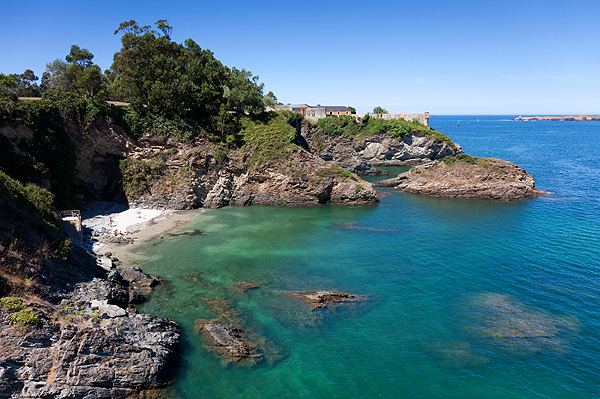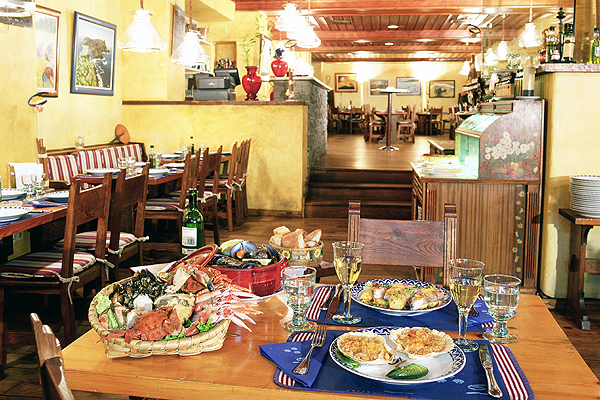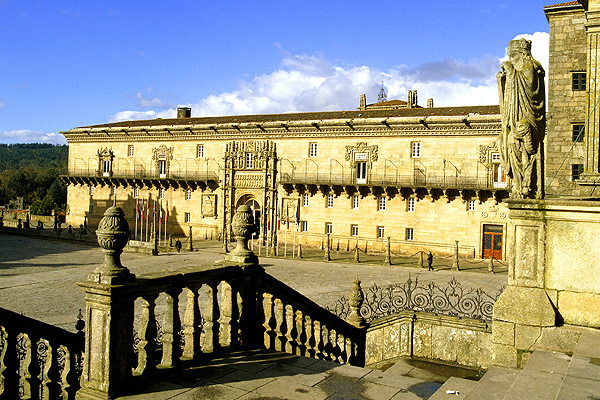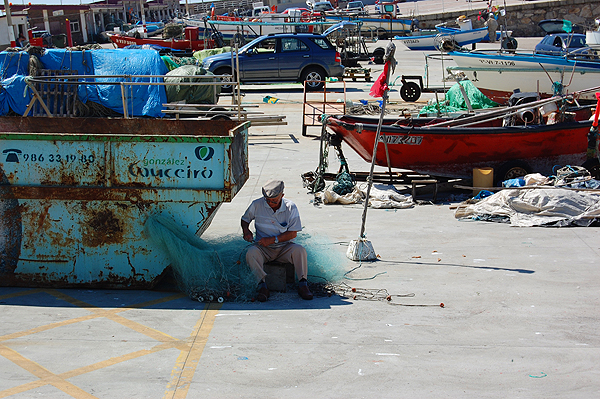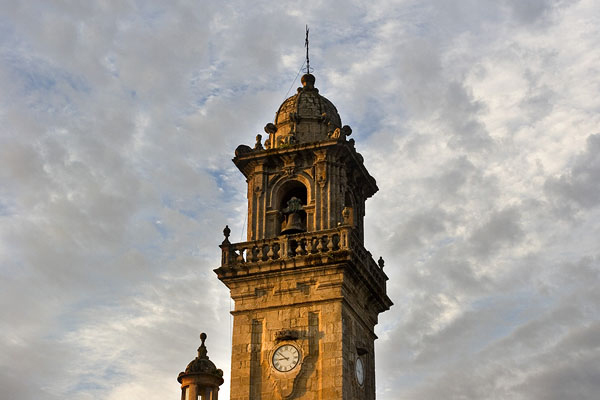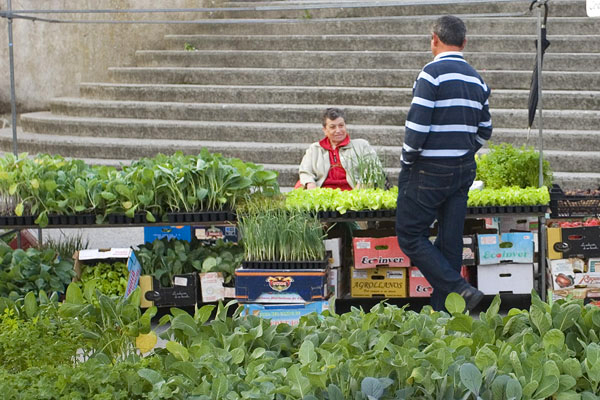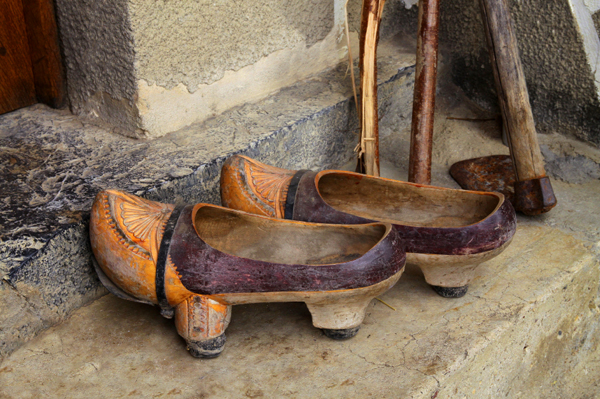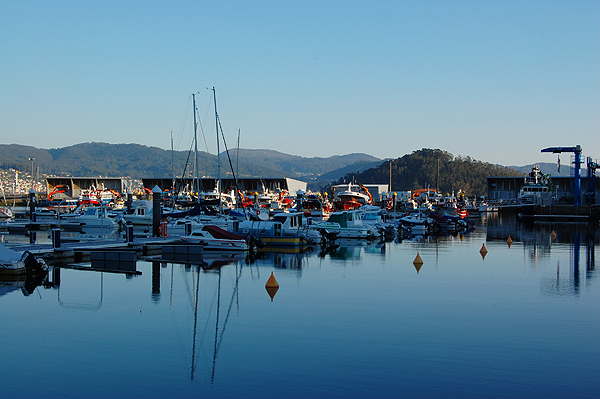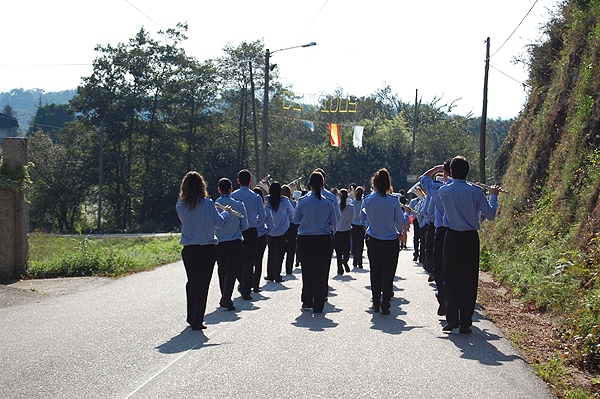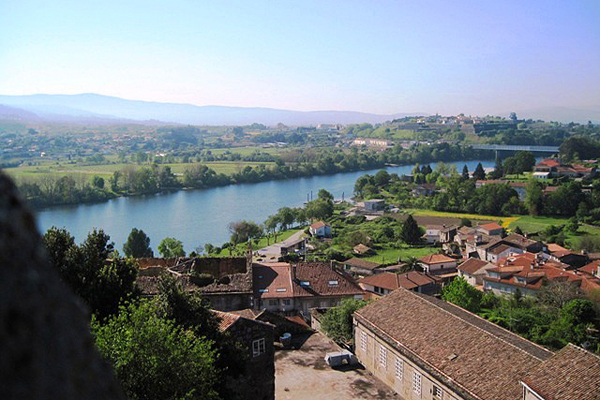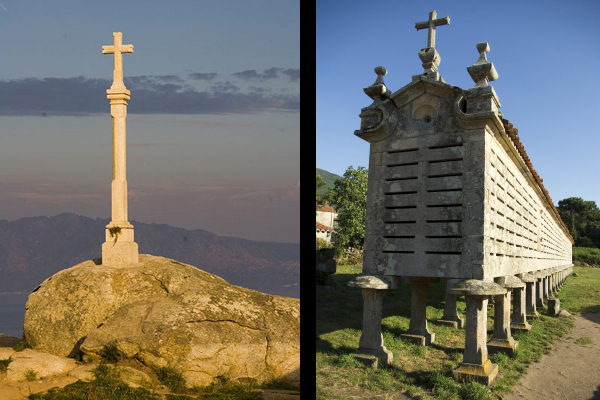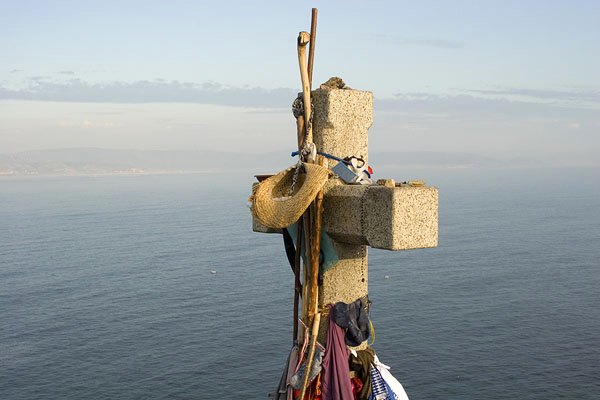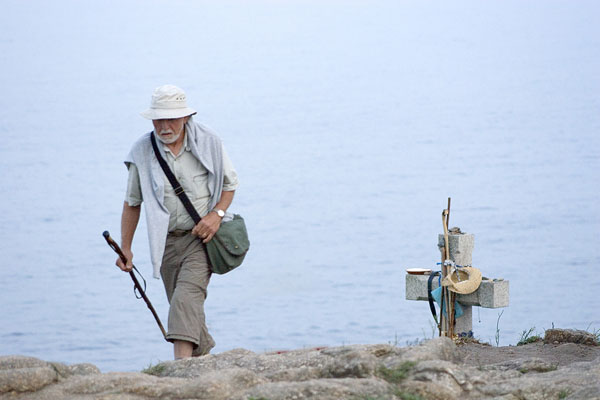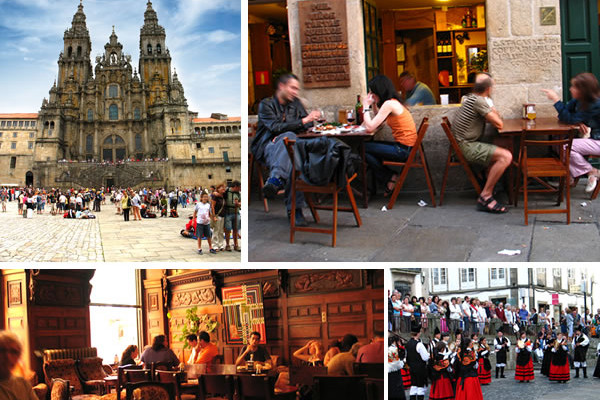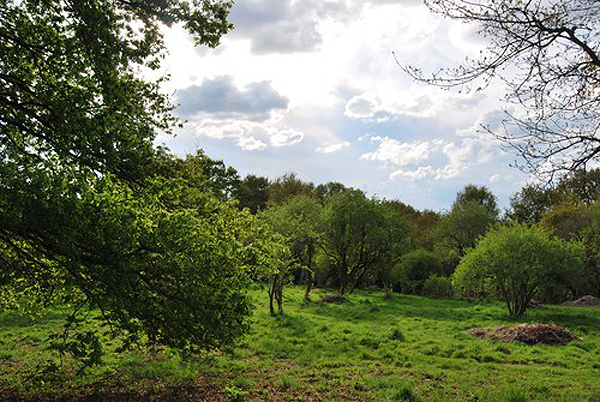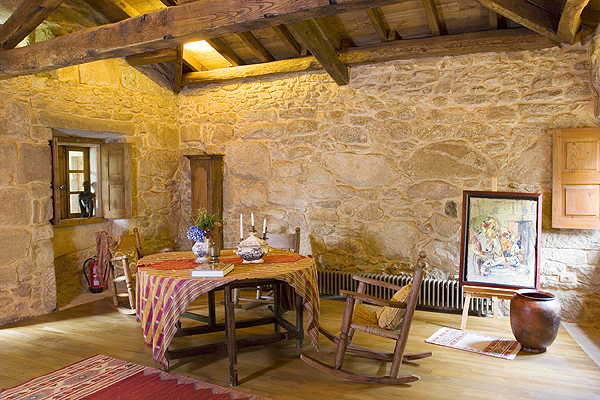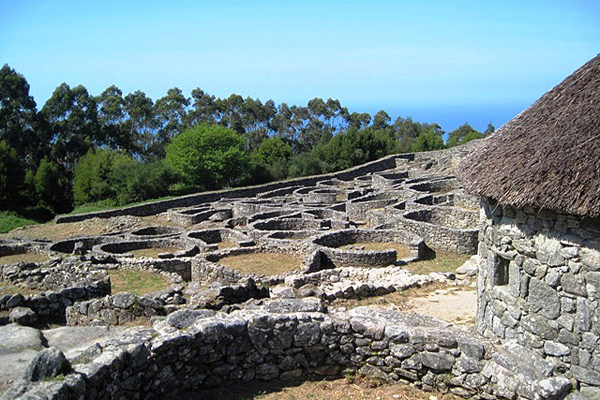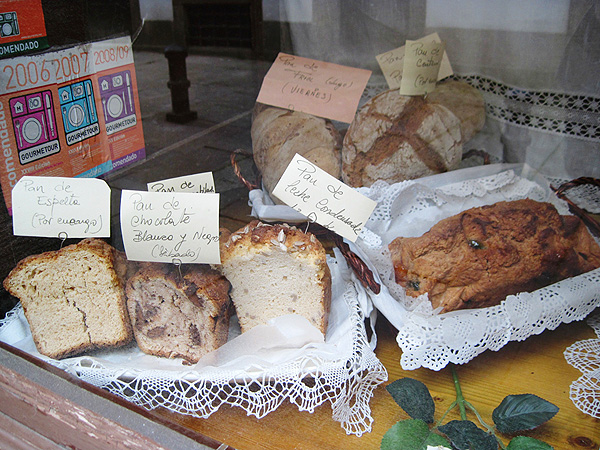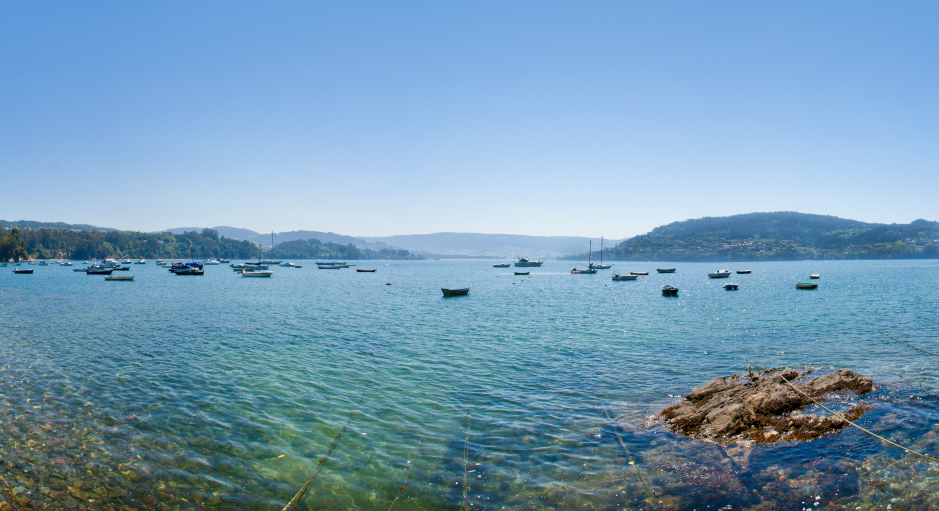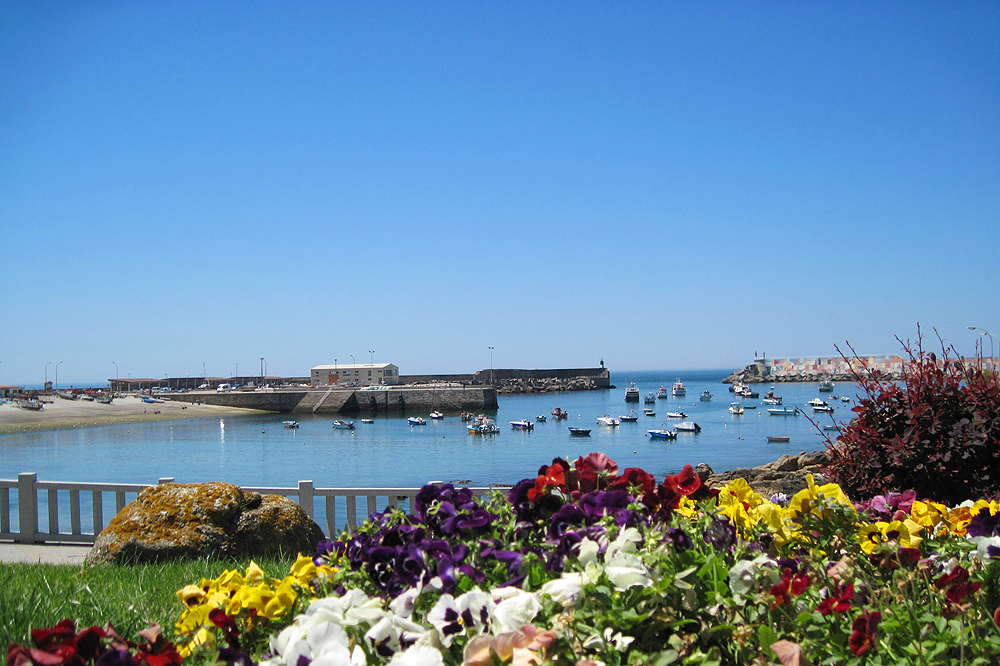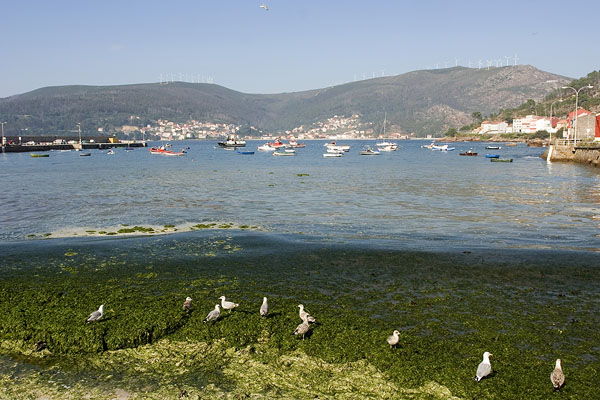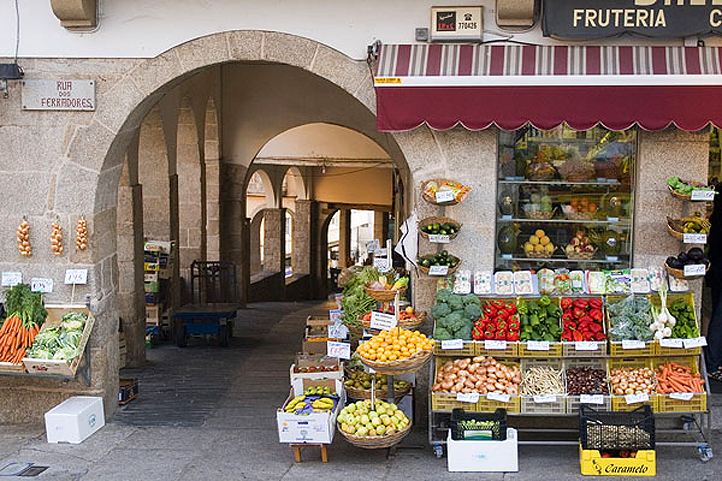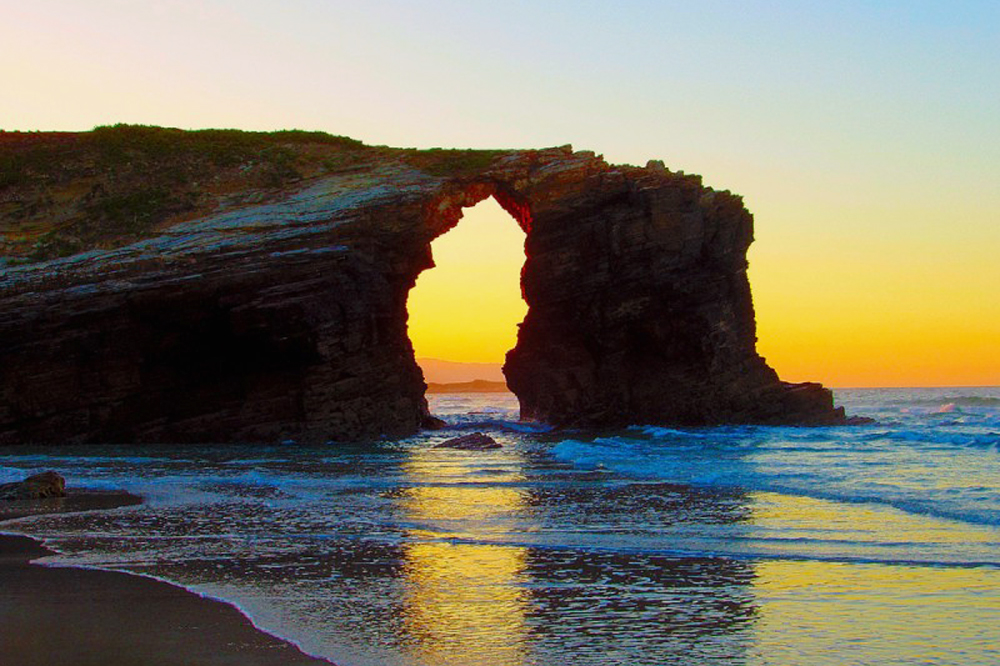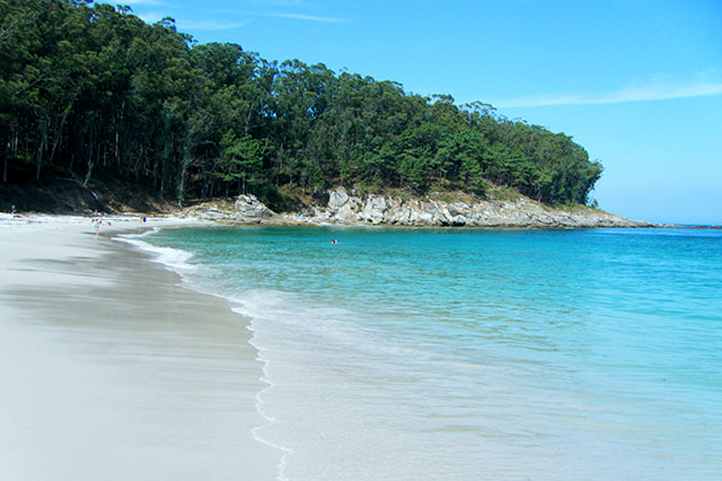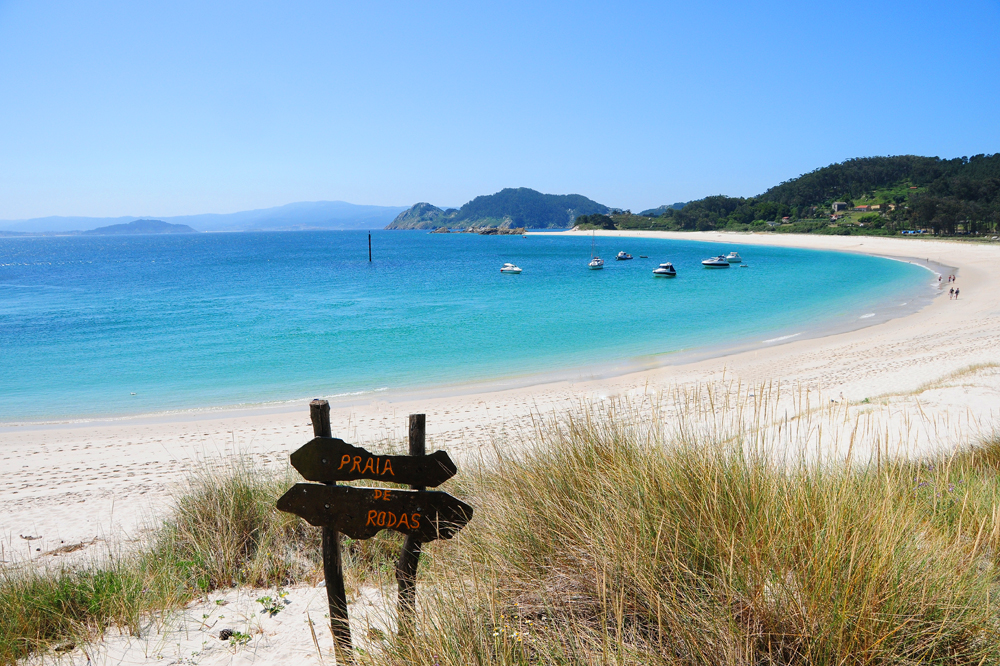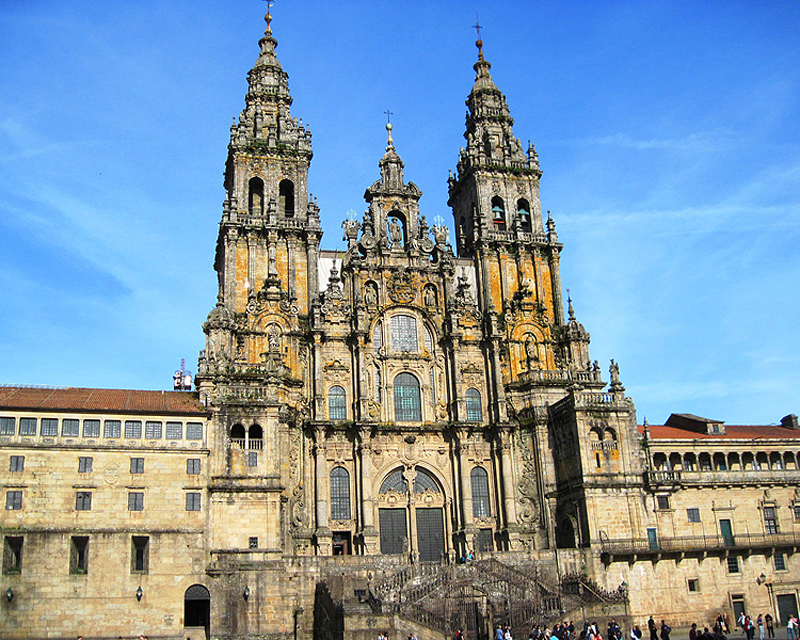This pleasant town, half coastal, half mountainous, is one of the northernmost in Galicia and its natural aspect is formed by the Serra da Faladoira range, which drops 600 metres down to sea level and offers wonderful walking. The beaches of A Concha, Picón, San Antonio and Fabega are a main attraction in Ortigueira (although Cariño is better for swims – see below) and you may wish to visit the neo-Classical 17th century parish church of Santa Marta and the old Dominican Convent.
A leisurely 15 minutes motor up a minor road brings you to the charmingly named Cariño (fondness, darling).
The cliffs here at Cape Ortegal are something to behold. Cariño has its gentler side in five beaches, from Playa Cala de O Peiral in the north to Playa Fornos to the south. Our tip is Playa Fornos, as the sea is gentler and better for swims.
The locality's outstanding claim to fame is its International Festival of Celtic Culture, which takes place every year during the first two weeks in July. Ortigueira becomes a cultural forum for Celtic lands of Galicia, Brittany, Scotland, Ireland and Wales. Music and live bands are the heart of the action and suitably supported by traditional crafts, sports and games, a food fair, courses and conferences.
Santiago de Compostela
Perhaps the most attractive small city in Spain, Santiago de Compostela is Galicia's capital and focal point. Famed as a pilgrimage destination, it is also an upbeat university town, where local, pilgrim, student and tourist mingle in well-kept streets, squares and parks. The splendid cathedral, which claims to hold the bones of St James the Apostle, is the main edifice in an old town of palace and monastery, museums and university buildings. Highlights are:
• The squares of Obradoiro, Quintana, Inmaculada and Praterías.
• San Martín Pinario Monastery, whose magnificent façade announces 20,000 m² of baroque architecture.
• Pazo de Bendaña is an 18th century baroque palace with a statue of Hercules holding up the world. Today it houses the Granell Foundation and Museum.
• CGAC (Galician Centre of Contemporary Art)
• Museo do Pobo Galego (Museum of the Galician People), housed in a former convent.
• Museo das Peregrinacións (Pilgrimage Museum)
• Alameda Park is Santiago's main park. It borders the old town and has shady areas, oak groves, statues, drinking fountains and a children's playground. Ideal for a picnic.
• Monte da Almáciga Park is accessed from another park, San Caetano, close to the bus station in the town centre. It slopes up to the city's highest point with a good view. Lawns, playground, benches, drinking fountains.
• Mercado de Abastos is the impressive covered market where you can stock up on fresh produce and provisions.
Rural Santiago:
Ponte Maceira
A continuation of the Finisterre Pilgrim's Way passes through the hamlet of Ponte Maceira, where a pretty stone bridge arches over the River Tambre. The bridge is mostly 13th century but built on original Roman pilings. In Ponte Maceira you can visit the old mill (molino) now converted into a café-restaurant with a terrace. It's in the Negreira district west of Santiago.
Suspended footbridge over the River Ulla
South of Santiago you will find the steel suspension bridge of Xirimbao over the River Ulla. The Ulla is clean and fresh and there are nice picnic spots along the riverside.
Pazo de Oca Palace and Gardens
Known somewhat effusively as the Versailles of Galicia, the baroque gardens (although not the private palace owned by the Duke of Medinaceli Foundation) are open to visitors.
Riamonte watermills hike
This 8-km walking route links a series of old watermills and has good views, too. Start at Vilar in the Ames district west of Santiago.
THE WEST COAST
Finisterre (Costa da Morte)
To feel the wind in your face, there's no place like Finisterre, where the Ancients believed that the world ended. A spit of land dwindles here to the loneliest lighthouse on the infamous Costa da Morte (Death Coast). At this legendary site of shipwrecks and Atlantic storms, you will see the ocean in a different mood than at southern beaches. Finisterre and its lighthouse at the "end of the world" represent the destination of both traveller and pilgrim, for whom it is the very last stretch and culmination of the Camino de Santiago after reaching Santiago de Compostela. If you want to hike a decent section of the pilgrimage way, then the route from Fisterra to Muxía is especially pretty, passing along fantastic beaches such as El Rostro and little hamlets that crop up unexpectedly along the way. It's a full 8 hours if you want to walk the whole trail.
There's an attractive beach below Finisterre village called Playa Sardiñeiro. We also recommend an area of Finisterre that most people ignore and that's the fishing harbour. If you go mid-afternoon, you'll see the fishing boats come in. In local Galician, Finisterre is called Fisterra.
Corcubión
Close to Finisterre, Corcubión has a harbour full of bobbing yachts and fishing boats and its own beach in Playa Quenxe. The main fishing port was destroyed during a French invasion in the 19th century and rebuilt completely; these days it's a lifeboat centre. You can learn to sail and kayak (full details in the Rustical Travel Local guide for Corcubión).
Mount Pindo
Continue down the coast to Monte Pindo. To the Spanish, the name Pindo evokes several legends. Sometimes and somewhat overstatedly called the "Celtic Olympus," it does bear certain strange inscriptions and a cult of the sun and stars led to its being excommunicated by bishops and kings. Other stories speak of the fabulous treasure of Queen Lupa. There are rock formations of animals and monsters and a wealth of medicinal plants on its flanks. Grass is said to grow prodigiously fast overnight on Monte Pindo.
If you take the path up to the top of Mount Pindo, it takes 2½ hours. The views are tremendous: the sea, of course, the superb Carnota beach nearby to the south, and the lighthouse at Finisterre the other way.
Ézaro waterfall
On the way to Pindo from Corcubión is a very special waterfall. At Ézaro you will find the only waterfall in Europe that cascades directly into the Atlantic Ocean. The River Xallas falls 40 metres to mix fresh with salt water. Since a dam was built upstream, you see the falls in action at certain programmed times and then it's a popular event for sightseers. On Saturday nights in summer, it is illuminated at night. A wooden walkway leads to the base of the falls. Ézaro in the Dumbria municipality has also a good beach, with waves for surfing.
Surf
For keen surfers we can recommend more than one beach. One of the best is Lariño at Muros. You also have Nemiña beach at Muxia and El Rostro at Finisterre.
Carnota beach
Magnificent. Before we reach Muros, we come upon Playa de Carnota. The longest and most impressive beach by far in Galicia, it has 6.5 km of white sand in a natural setting.
RIAS BAIXAS
Muros & Noia estuary
The town of Muros on the estuary has an old quarter which is pleasant to stroll around; you will see some town houses emblazoned with coats of arms. At Noia, we suggest the 1.3 km long sandy beach of Playa Testal.
Vilagarcía de Arousa & Arousa Island
Playa de Compostela beach (also known as Playa de la Concha) is sheltered, has lifeguards, and backs onto Vilagarcía fishing town with its cafés and restaurants. Parking nearby is usually quite easy. Avoid areas where local fisherwomen are at work, raking out the precious clams, as the water here can turn cloudy.
South of Vilagarcía, attractive, fine sandy beaches are to be found on Arousa Island ("Illa de Arousa" in local Galician). Formerly only reachable by boat, there is now a bridge that joins the mainland just south of Vilanova de Arousa. It's an inhabited island with good facilities.
Pontevedra
Pontevedra town has an enchanting old quarter with squares such as Praza da Leña where we recommend a visit to the provincial museum followed by tapas at any one of the bars. The monumental 15th century Basílica de Santa María Mayor is the city's grandest temple and you may also wish to visit the church of Santuario de la Peregrina in Praza de Peregrina square. Off the main street Gran Vía de Montero Ríos are the green parks and gardens of La Alameda and Jardines Vicenti.
Atlantic Isles
The idyllic Atlantic Isles off the west coast of Galicia are a Spanish National Park and natural treasure, where vehicles are not allowed and you can enjoy some beautiful walks through the wilds and beaches of fine white sand with turquoise waters. Apart from the wonderful sandy beaches and woods on the islands, there are paths that take you across the islands to the western cliffs. Rodas beach on the main Cies Island has been called the best in the world, but be warned: the water is freezing...
The islands form two small groups, Illa de Ons to the north and Illas Cies to the south. Boats to Ons Island leave from Portonovo, Sanxenxo, Bueu and Marín from late June to September and some weekends. Boats to the Cies Islands of Monte Agudo and O Faro leave from Vigo, Baiona and Cangas. For more routes and schedule information, visit Mardeons.com
Vigo
With a population of 300,000, Vigo is the main town for Rías Baixas and Pontevedra region. it is often overlooked by visitors, yet it has an old town with much to recommend it and is built on hills that slope down to the sea, giving the visitor a San Francisco-like experience.
In summer months, from Vigo harbour, boats leave regularly for the magical Cies Islands. There are gorgeous white sandy beaches here. You can eat on the boat over, but a restaurant on the island also offers meals at no extra cost. Starting at Vigo port, you may see transatlantic ocean liners in dock. Right here, and lying in wait for their passengers, is a de luxe shopping centre called A Laxe. Cross over the walkway to the old town and you will come to Calle de la Pescadería, a street famous for its fresh oysters (ostras), ideally accompanied by a glass of chilled white wine. Vigo Tourist Office is nearby.
The Montero Ríos street in this area is where you will find terraces galore for drinks and lazy lunches. Afterwards, depending on how fit you're feeling, you might continue up the hill in the green park called El Castro, for a fine view over the estuary. There are swings for children, plenty of trees and a café-restaurant at the top, by the fortress which gives the park its name.
Samil (with waterslides and pools for children) and El Bao beaches (playas) south of the city are long, popular and sandy with good facilities. Along the same stretch of coast you will find various smaller, quieter beaches.
If it's nightlife you're after, Vigo has dozens of venues, among which the best known are La Iguana, Tzameti Vigo, El Monstruo de un Solo Ojo, 20th Century Rock and Detras de Marco.
SOUTHERN GALICIA
It is the warmest area of the region. Here you will find vineyards for Galicia's fresh and fruity white wines.
Baiona
The great fortress of the coastal town presents itself across the water as a giant wall. Never assaulted in war, nor scavenged by the local citizenry for its fair granite, the fortress is a weighty reminder of an older Spain, when Catholic monarchs were building defenses against resurgences of the Moors in the south and unknown enemies by sea. It costs about 5 € to drive in. From the look-out tower which once doubled as a lighthouse, the Cies Islands float in a distant haze upon the ocean. On the waterside below you to the right, look out for the square-shaped rocky remains of a Roman holding tank, where fish were kept alive before being transported to city destinations.
All along the sea here is a maritime walkway that continues back to Baiona town. A walk from tower to tower along the 14th century wall gives a changing view of the boat-filled harbour round to Vigo Bay, and far out to sea. In the harbour, you will spy an old galleon, or rather the replica of one: nothing less than the Carabela Pinta, which arrived here on 1st March 1493 to announce the discovery of America by Christopher Columbus. Across the bay, you will see the long, golden strand of Playa América.
If you found the water of the Atlantic Isles beaches cold, here it's notably warmer and the water is normally calm for swimming. Just behind the Baiona harbour road is a street with a number of restaurants that are second to none in their variety of crustaceans and fish. When we last visited, a seafood paella for two people was offered at just 18 euros.
Monte Tecla
An interesting drive round the coastal road takes you from Baiona south to A Guarda where you can drive up to the ruins of a 1st century BC Celtic hill fort. Monte Tecla (also called Monte Tegra) was a major settlement of 5,000 people. We recommend a visit not least on account of the view from up high down the estuary of the River Miño and out to the ocean. A Guarda has a promenade by the harbour lined with fish and seafood restaurants.
Little car ferry over to Portugal
One of our favourite highlights in southern Galicia is the modest little ferry at A Guarda which crosses the River Miño to Portugal, from Camposancos to Caminha. We've been monitoring availability of crossings because we know that the river needs dredging and that town councils on either side are waiting for their national governments to take action, or the ferry will be lost. If the ferry is operating, it's an ideal (and very cheap) way to enter Portugal and continue south to beaches at Moledo or Ancora.
Tui
This delightful town grew up on the banks of the broad River Miño, which forms a natural border between Spain and Portugal. It is a traditional and graceful old town, extraordinarily under-visited. Those who do come will find it's a treat, with good choices for cafés, restaurants and evening terrace bars. Little squares, bedecked with flowers and sweet jasmine, intermingle with the crafted granite of dignified residences, convents and churches. Look on the streets for grooves carved by carriage wooden wheels. One convent is home to walled nuns, who are never seen. They access their convent garden on the other side of the street via a tunnel. The sisters bake small almond "fish" that make for a popular cake with the locals.
The marvellous fortress-cathedral of Saint Mary in the old town is a mixture of Gothic and Romanic styles. The cloister gardens are an oasis within an already peaceful town and the cathedral tower affords an unbeatable view up and down the River Miño and across to Portugal. From Tui cathedral you can see the fortress in Portuguese Valença, and vice versa. The cathedral, built as a bastion against potential invasions, is magnificent for a relatively small town. Enter via the splendid Romanic portico and pay 2 € to stroll round the inner cloisters and climb up to the top of the tower (even though there's a light switch, it's still dark, so mind the steps!).
The central Corredoira street below the cathedral quarter is where the people of Tui promenade and where you will see a monument to a monk who brought seeds to spread the mixed blessing of the eucalyptus throughout Galicia. The broad Corredoira street has some old establishments along it and is a popular place for the locals to promenade. An antiques market is held here on the third Saturday of the month.
River Miño
The river running between Galicia and Portugal is an attraction in itself, wide and slow-moving. You can swim in it, hire kayaks, or cycle along it. From Tui, an old iron bridge built by the school of Gustave Eiffel crosses the Miño to Valença in Portugal.
BEST OF THE REST
Betanzos
This beautifully preserved, small medieval town near A Coruña also has the reputation for the best tortillas de patatas (Spanish omelettes) in all of Spain. We often recommend Betanzos to people driving a long way to Galicia and who need somewhere to rest and spend the night.
Stone crosses
You’re bound to see these, often eaten away by wind and rain. They combine Catholic tradition with native Galician superstition, since they are sometimes placed at junctions to guide recently deceased souls to the cemetery.
Camariñas
On the Costa da Morte, from Cape Vilán lighthouse at pretty Camariñas, a good 19-km dirt track follows the coastline round to Arou and Camelle. Kite-surfing is popular along this stretch of coast. This wonderfully panoramic drive can be enjoyable even in wind and rain, although during good weather there are the most spectacular views of the waves jostling in the ocean, Vilan lighthouse on the horizon, sand dunes and unspoilt beaches such as Playa del Trece and Reira. You pass by an English Cemetery, resting place of sailors from the British cruiser HMS Serpent wrecked off the coast here in 1890, before coming to the little village of Camelle. Every year during Easter week, a Camelle holds a fair for the embroidered lace work it is best known for.
Vimianzo
Inland from Camariñas, Vimianzo has a well-preserved medieval castle. There are exhibitions here at Easter and in summer of lacework and other arts and crafts.
Fiestas
A curious event held on the first weekend in July at Sabucedo near A Estrada is the horse-taming known as Rapa das bestas. Wild horses (road signs you see for wild deer usually signify these) are quite common in the area and once a year young men capture and wrestle with the horses to tame them, cutting short the tails and leaving a brand.
Where you are staying in Galicia, you are likely to come across a fair that, sensibly enough, centreson seasonal delicacies. A particular speciality in Tui, for example, is the angula, or baby eel, while other gastronomic days feature clams, prawns, mussels and albariño wine.
O Grove, Sanxenso & Portonovo
These built-up coastal towns are very popular with Spanish tourists, who flock here for the beaches, restaurants and vibrant nightlife. If it’s discos, clubs and fiesta you want, here at Marbella of Galicia is where to find it. One of Galicia’s best beaches, La Lanzada, is situated on the south-west side of the isthmus that joins the O Grove peninsula to the mainland, south of Vigo. It is a blue flag beach, beautiful, sandy and so huge that even in August it’s never that crowded, although weekends are best avoided.
Costa da Morte beaches
• Playa Gures in Cée by Corcubión: there’s no car access , in fact you have to walk along a path for 15 mins, but you arrive at an impressive and beautiful beach.
• Playa Langosteira in Fisterra (Finisterre): big and lovely in an area of pine forest. Has a promenade along the sea all the way to Fisterra.
• Playa San Pedro in Carnota: a pretty beach at the foot of Mount Pindo, if by no means as superb as nearby Playa Carnota itself.
Two walks in the Galicia interior
Zobra circular walk: Deep in the Pontevedra hills, from the little-known hamlet of Zobra, a pathway leads you through woods and by rivers. The full circular route of 20 km takes 6 hours, so you may just want to walk part of it.
A walk among some of the tallest trees in Europe: Just 20 mins from the villa, a special place to take children for a short, easy stroll is Fraga de Catasós. This small wood of chestnut, oak and cork oak features the fastest-growing trees in Europe. There are 200-year old chestnut trees with a girth of 18 feet that stand a hundred feet high. It’s very alive, full of toadstools, lichens and ferns. There’s no parking by the wood itself, so leave the car 100 metres away in nearby Quintela.
Pazos de Borbén
This interior district is characterized by pretty villages such as Moscoso in typical Galician stone style, the healthy rivers of Borbén, Barragán, Pozo Negro and Tea, old water mills (60 in the Pazos municipality alone) and local architecture: traditional, simple and charming. It’s a mountainous landscape where cattle and horses move freely about, including autochthonous wild horses. Petroglyphs at Tenxiñas attest to settlement of the region since Bronze Age times.
Combarro
One-hour excursions in catamaran are offered in summer months from Combarro harbour. You travel up the estuary to see the floating beds where mussels, oysters and scallops are grown, and can watch the seabed go by beneath the boat through a glass viewing panel. Includes a sampling of mussels and local wine.
In the coastal Poio municipality, Combarro stands out for having examples of traditional stone architecture, winding streets of granite, stone crosses and hórreos: grain stores raised on supports to keep the valuable grain away from rodents. Just 10 mins from Combarro, on the way to Pontevedra, you can visit the baroque Benedictine Monastery of St John and also see the biggest hórreo in Galicia, which is held up by no fewer than 51 “legs.”
Apart from the local beaches in Poio, you might like to try out one of those in Pontevedra estuary by Sanxenxo, Portonovo and Fonte de Ons, 15 to 25 minutes away. The water is a little warmer than at beaches open to the Atlantic Ocean. There are usually plenty of locals there and a summer bar for cocktails, drinks and snacks. Entrance and parking are free.
Arqueological site
Parque de Arte Rupestre de Campo Lameiro. To see Bronze Age art at a major site of petroglyphs with a visitors centre and recreated village, we suggest this site 30 km from Combarro.
More beaches
There are two beaches at Redondela. One is small and in an urban area of Chapela. We recommend the other beach, called Praia da Punta, which is much bigger and more natural, at Cesantes just north of Redondela. It has golden sand and good access by car or foot. The water is calm and good for swimming.
Marine tourism
If you’re close to a port, it’s worthwhile asking about visiting the platforms (bateas) and areas where mussels and other shellfish are cultivated. It’s a tourist activity that is becoming more commonplace. The experience typically involves trying out the freshest of fresh seafood. Another way of getting to know the coast is by visiting one of the 55 lighthouses in Galicia.
FOOD AND DRINK
Galician cuisine is just about the best in the whole of Spain, especially when it comes to seafood, and the region produces excellent white wines to accompany squid, clams, mussels, cockles or baked fish to perfection.
Beef fattened on the region’s green pastures is healthy and tasty, too. The predominantly hilly and forested landscape is dotted with small villages, where one will typically find a local hostelry whose simplicity belies a capacity for serving marvellous food and wines.
In addition to the regular, appetizing menu items, you may find Galician regional specialities such as:
• Lacón con grelos - Pork shoulder with turnip greens is a classic Galicia dish, often accompanied by chorizo
• Pulpo a feira - If you’ve never tried octopus and think that suckered tentacles sounds eating like strips of rubber bathmat, think again. Pulpo a feira is a tasty, light and delicious dish. Galicia is the place to try octopus, so seize your chance! Tenderized and boiled to perfection, the pulpo a feira is cut up with scissors into thin slices, sprinkled with paprika, rock salt and olive oil and served up with cachelos, slow-boiled local potatoes. As in any good Celtic land, the Galicians are discerning connoisseurs of the potato. Indeed, the Kennebec variety bears a Protected Designation of Origin pedigree in the European Union.
• Percebes - Goose-necked barnacles are a prized speciality whose high price reflects the life-threatening lengths that fishermen go to when grabbing them from rocks between crashing waves. Find out more in our article and recipes for: Gooseneck barnacles and fairground octopus
• Roxons - Considered one of the best of all the Galicia tapas, roxons is shredded pork cooked in butter, served in or with bread.
• Empanada - A widespread and filling staple, empanada is a pie of thick pastry normally, but not always, with a filling of tuna or cod, tomato, onion and green pepper.
• Pimientos de Padrón - These little green peppers were first brought back from Mexico to the Padrón, south of Santiago de Compostela a by Franciscan monks. They have an engaging flavour and eaten fried with a shaking of coarse salt. At the former Franciscan convent here (now a school) in the parish of Herbón, on the first Saturday of every August, thousands of locally grown peppers are fried up and given to visitors and tourists. As befits their exotic origin, once in a while, one of them will turn out to be fierily spicy, but you never find out until you bite into it...
• Cocido gallego - Galica’s traditional pork and chickpea stew is a family favourite that is eaten everywhere, especially pre-Lent. Lalin goes one better than the rest and celebrates the stew with its very own February fair.
• Lamprea - The lamprey is said to have a flavour somewhere between fish and meat. This odd fish, jawless, scaleless and slippery, has become quite a speciality in Galicia. To distinguish the prized local lamprey from imported French imposters, some restaurants have started to barcode the eel-like fish with information that mobiles can retrieve to show when and where it was fished, even the name of the boat.
• Tarta de Santiago - For dessert, especially if you’re visiting Santiagp de Compostela, try Tarta de Santiago, an almond cake whose sugar-dusted top is printed with cross of St James.
• Filloas - Galicia has a tradition for pancakes going back to Roman times. Filloa crêpes are especially popular at Carnival time, not unlike pancakes on Shrove Tuesday in the UK. Fillings include quince jam, chocolate, boiled chestnuts and whipped cream.
• Flan de queso - Galicia’s version of crème caramel is made with O´Cebreiro cheese.
Galician wines
Although some surprising red wines originate in Galicia, it is the whites that are justly celebrated. Three major varieties of grape: Ribeiro, Godella and Albariño, all very good (while the latter produces the superior wines), are served well chilled to clean, zesty and very palatable effects. Local supermarkets are the simplest way of buying wines, but if you want to visit the bodegas (wineries), and buy direct from the vintner, there are no fewer than five denominations of origin: Monterrei, O Ribeiro, Rias Baixas, Ribeira Sacra & Valdeorras.
The 5 Pontevedra wine routes that correspond to these denominations can be downloaded onto your phone or tablet in English, German, French or Spanish via an app from the regional tourist board’s website Turgalicia. Why not explore the Pontevedra vineyards online first and then come try them out?
• Licor de hierbas - Sipping a shot glass of this sweet, lime-green herbal digestif is a common way of concluding a meal in Galicia.
• Orujo - Made from fermented grapeskins, orujo is more hardcore than licor de hierbas, colourless but potent.
• Queimada - Last but not least, an experience that is as much a poetic ritual as a drink. Although in essence a private affair between friends, you may well have the chance to assist at the ritual and sample the brew in a restaurant. The queimada is an exclusively Galician affair and an illustration of the pagan culture that has always informally coexisted here with Catholicism.
In a large, glazed, earthenware bowl, aguardiente liquor is pre-heated before adding sugar, orange and lemon peel and coffee beans. The mix is then set aflame and slowly stirred with a large spoon. The flames are at last allowed to rise as a protective spell is chanted, often invoking spirits and demons, and preferably spoken by a Galician meiga, or witch, before the potion is shared out among those present. The queimada is said to resonate with all three of the main civilizations that have made their stamp on Galicia; the poetic element of spell harks back to the Celts; the penchant for flaming concoctions reminiscent of the Romans and Germanic tribes; while the aguardiente liquor was an invention of the Arabs. The Galician queimada has two festivals of its own to celebrate the ritual. One is held in Sada (La Coruña province) on the last Saturday in August; the other is in Cervo (Lugo province) on the first Saturday after 16th August.
Santiago de Compostela restaurants
Whereas in many places there are not so many restaurants worth serious recommendation, in Galicia the story is different, and particularly so in Santiago de Compostela, where there are lots of good places to eat out!
The recipe for success in Galician cuisine is often simplicity in the approach to cooking and the use of top quality ingredients. You can read our latest article about Galician local cuisine.
As top quality ingredients are always expensive, the best restaurants are not that cheap, although they are considerably more so than in Madrid and a real bargain compared with London. Galician ingredients are simply superb and at least one of these restaurants is certainly worth trying if you find it affordable.
The amount of food served is often surprising generous and occasionally extraordinary (if less so in the top restaurants), so don’t order too much to begin with! Galicians are appalled at the idea of someone not having had enough to eat, and will often offer to put more food on your plate in case you are still hungry.
You should generally expect to find restaurants open for dinner from no earlier than 8.30 pm until about 11.30 pm, and lunch from 1 pm to 3.30 pm.
Superior Santiago restaurants:
For most of the restaurants listed below (except the most economical options), you should book in advance.
• La Tacita de Juan - This famous, popular restaurant has a good reputation with locals. You can have a quality meal with three courses and drinks (specialities menu) for about 40 / 45 euros per person. Hórreo, 31. T 981 563 255 Closed on Sundays.
• El Asador Castellano – A good place to eat traditional Spanish roasted meats prepared in old-fashioned ovens. Lamb from Castilla is particularly recommended. Top quality meat, so prices are relatively high and the style may be more Castillian than Galician. Calle Nova de Abaixo, 2. T 981 590 357. Closed Sunday nights and Mondays.
• O Curro da Parra - Inventive cuisine, traditional but trendy and modern at the same time: the equivalent of a British gastropub, but in Galicia. This place has had gained in popularity recently. It is centrally located. Calle Travesa, 20 baixo T: 981 55 60 59.
• Don Quijote - This traditional restaurant is a reliable choice. The premises may be unexciting compared to other more contemporary establishments, but we're talking food here, and it's of great quality with traditional Spanish and Galician dishes. Expect a very good and correct service to go with it. Rúa das Galeras, 20. T 981 58 68 59.
• Casa Marcelo - Galician sushi and creative cuisine. Well-known chef with over 20 years experience and a Michelin star. There are speciality menus for around 45 euros per person. Calle Hortas, 1. Tel: 981 558 580. Closed from Sunday to Tuesdays.
Mid-range Santiago restaurants:
• O Dezaseis - A great option with a good reputation. Originally stables, it has traditional charm and a busy, positive atmosphere. Close to but not in the historic centre.
• La Bodeguilla de San Roque – Small and traditional. Good food and wine and fair prices. Can get busy.
• La Bodeguilla de San Lazaro – has a reputation for great food at fair prices. Outside the historical centre.
• San Clemente - Galician cuisine. A good choice for a seafood feast. The price can be fairly high while remaining within reason. Calle San Clemente 6, T 981 565 426
Nicely priced Santiago restaurants:
These may be humbler but they're still good. Some are popular with with Santiago pilgrims.
• Os Bigotes - Several people have told us that their home-roasted ham sandwich rolls (bocadillos de jamón asado) are cheap and delicious. Calle Raiña 7. T 981 561 942.
• Belgo – For mussels and white wine. Are these the best mussels in Spain? Be sure to order Albariño wine to go with them. Calle Travesa 22, Bajos. T 981 259 030.
• O´Filandón – A delicatessen shop with a bar at the back. Traditional and cozy. A good variety of good homemade cold meats, rolls, omelettes, wine: all very tasty. Calle Acibachería 6, T 981 572 738.
Other Galicia restaurants:
Rural Santiago
O Fogar do Santiso – Somewhere different. A thoroughly rustic bar-restaurant located in a forest 13 km south of Santiago. The food is simple and includes vegetarian options and organic vegetables from their own market gardens. The place is rather unusual and has lots of character. See location on googlemaps: http://goo.gl/maps/Hjima
A Estrada
• Restaurante Samaná - A sophisticated venue. Calle Gradín.
• La Estación -Traditional home-cooking. Next to the Guardia Civil police barracks on Avenida de Pontevedra, the main N-640.
• La Bombilla - Offers good meat and fish dishes and a set lunch. Plaza de Galicia, 5.
• Don Juan – Similar menu to La Bombilla. Carretera Forcarei, 37 (the PO-7001 road).
Forcarei
• Restaurante Victoria - Very good. Calle Progreso, 5 (the main road through the village).
• Aciveiro Monastery is a magnificent venue for that special evening out. The 12th century Monasterio de Aciveirois north-east of Forcarei on the N-534 road. GPS 42°37'05.4"N 8°18'05.7"W
Coastal Galicia
Pontevedra
• Restaurante Román – Our tip for one of the best seafood restaurants in the region.
• Connoisseurs of seafood on an excursion to the coast should note that the locality of Arcade between Pontevedra and Vigo is synonymous with seafood restaurants (marisquerías).
Corcubion
• Restaurante San Martín - especially good for having raciones (plates of whatever you fancy, normally shared between everyone). Good service and value-for-money. Recommended raciones here include pulpo (octopus), calamares (squid) and zorza con patatas (minced pork with potatoes).
• Alborada - also good for all kinds of raciones. Try pimientos del padrón (sweet green mini-peppers) and tortilla casera (homemade omelette).
• As Hortensias and Praia de Quenxe - both offer views of the local beach (Playa de Quenxe) and serve up the best this coastal area has to offer: seafood and fish. Good for families.
Finisterre
• Restaurante Tira do Cordel - If you fancy very good fresh fish, we recommend the sea bass (lubina). It's a bit pricier than other places in the area but worth it. Located at the entrance to the village.
Southern Galicia
Tui
• O Vello Cabalo Furado - From the Corredoira street, walk up the steps and you'll come directly to the old town which is very beautiful and generally quiet. Past a craft-and-souvenir shop on the corner selling some Celtic-design items you will find this restaurant on a corner. If it's closed or busy, it has a second restaurant O Novo Cabalo Furado which you will see clearly signposted ahead.
• Restaurante Silabario - Traditional Galician fare is given a stylish and modern turn at this sophisticated venue.
• Vinoteca de García close to the Cathedral Square is a winebar that also serves meals.



































